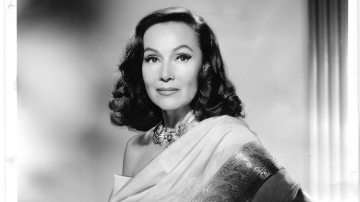Dolores del Rio: The First Latina Hollywood Star
Iconic Mexican Dolores del Río rose to stardom in the Golden Age of Cinema and was a Latina pioneer in Hollywood

Photo of Dolores del Río/Public Domain
During Women’s History Month, it is important to remember all the Latinas that came before us. Those that blazed the trail, broke barriers, and opened doors for Latinas today. From activists like Sylvia Rivera to trailblazers like Supreme Court Justice Sonia Sotomayor, Latinas have consistently impacted and influenced history and generations of people. To keep with the tradition of highlighting history-making Latinas, we’re taking a look back at those Latinas whose legacy can still be felt now. One of the most groundbreaking Latinas is none other than Mexican actress Dolores del Rio, the first Latina to successfully crossover to Hollywood. Del Rio’s career set a precedent for Latinas in Hollywood, U.S. crossovers and what Hollywood actresses could look like, when at the time there were very few Latinas in the industry. From dominating silent films to taking over the Golden Age of Cinema, the iconic actress was an example of the heights that Latinas could reach and the talent they possess. Read on to learn more about this history-making actress and the breadth of her career.
Early Life
Born María de los Dolores Asúnsolo y López-Negrete in Durango, Mexico in 1904, the actress known as Dolores del Rio came from a wealthy, aristocratic family with roots in Spain. Her father was Jesus Leonardo Asúnsolo Jacques, a director of the Bank of Durango and her mother was Antonia Lopez-Negrete. Early on, del Rio developed a love for performing which would eventually lead to her legendary path as one of Mexico’s most recognized actresses. The comfortable lifestyle she and her family had become accustomed to was soon taken away by the onset of the Mexican Revolution of 1910-1920 and the insurrection of Pancho Villa. Her family was forced to flee Durango following the arrival of revolutionaries and relocated to Mexico City.
Some time following their relocation, she would meet and marry her first husband Jaime del Rio in 1921. It was her husband who connected her to Hollywood director Edwin Carewe. It was Carewe who invited her to Hollywood and try her hand at acting in the United States, which Del Rio accepted, hoping to rebuild with her husband economically.
Hollywood Crossover
Del Rio’s first film was the 1925 silent romance comedy Joanna where she played Carlotta de Silva. It wasn’t until she starred as Charmaine de la Cognac in What Price Glory (1926)—which was one of the highest-grossing motion pictures, about $2 million, of that year— that her career started taking off. From that point on Del Rio had back-to-back roles in Hollywood silent films, primarily directed by Carewe, including Resurrection, The Loves of Carmen, The Other Woman and Ramona. Carewe’s vision of Del Rio was to create a counterpart to Rudolph Valentino, a popular silent film actor known as “The Latin Lover”’ despite his Italian heritage. The actress’ rise to stardom as a sex symbol caused tension between her and husband which led to their separation in 1928 before his mysterious death shortly after. Carewe soon became possessive of her and her career, with Del Rio inevitably cutting ties with him. This new beginning in her career management came right as Hollywood films were having a new beginning of their own.
The Hollywood “Talkies” & Return to Mexico
Especially during the age of silent films, Del Rio’s her complexion made lighter in film to counteract racism and anti-Mexican sentiment. As the “talkies” emerged, she would become one of the few to survive the transition in Hollywood and the use of sound would surface new issues with racism. Her first talkie was Bad One (1930), a romantic musical she starred in which showcased her voice with an accent. Because of this, she was subject to typecasting, often leading to highly exoticized and stereotypical roles like Belinnha de Rezende, a Brazilian woman in Flying Down to Rio (1933) or Luana in Bird of Paradise (1932), while also playing more European roles like Duchess of Rye in The Widow from Monte Carlo (1936) due to her Spanish heritage and lighter complexion. Over time, Del Rio’s casting in films became tied more closely to her beauty and stereotyping of exotic Mexican women—for instance, Girl of the Rio where she plays a “spicy” Mexican dancer. By 1943 the actress decided to part ways from the Hollywood limelight and return to Mexico. Despite her casting in exoticized roles, she was continuously referred to and billed as a “Spanish” actress which she had to fight against during her career in order to be known and recognized as a Mexican actress.
When she returned to Mexico in the 1940s, she achieved great success and soon became a quintessential part of the Golden Age of Mexican cinema. Some of her Mexican film credits include Flor Silvestre, La Selva de Fuego, Las Abandonadas, Bugambilia, and Maria Candelaria. The latter being the first Mexican film screened at the Cannes Film Festival and winner of the Grand Prix in 1946. Her career in Mexican cinema did not go unnoticed with her earning four Silver Ariel Awards—Mexico’s equivalent to the Academy Awards. Del Rio’s magnetism and talent proved to transcend genres, language and countries.
Later life & Death
Dolores del Rio’s impact continued beyond her acting work. In 1957, she became the first woman to sit on the Cannes Film Festival jury, a major feat for women and Latinas in the industry. In 1964 she was also one of the founders of Sociedad Defensora del Tesoro Artístico de México, an effort to preserve and protect “artistic heritage”. Del Rio made her final film appearance in the 1978 film The Children of Sanchez as Grandma Paquita. That same year she was also honored with the White House diploma and silver plaque for her contributions to cinema and her work as a cultural ambassador of Mexico in the United States
Del Rio passed away on April 11, 1983 in Newport Beach, California at age 78. She is buried at the Rotonda de las Personas Ilustres in Mexico City—a burial site for those their cultural and historical impact in Mexico. She will forever be remembered as one of the most groundbreaking and impactful Latina actresses. While facing the racism and challenges of her time, Del Río uplifted her Mexican identity above and it is because of her that doors have opened so many Latinas in Hollywood today.

















